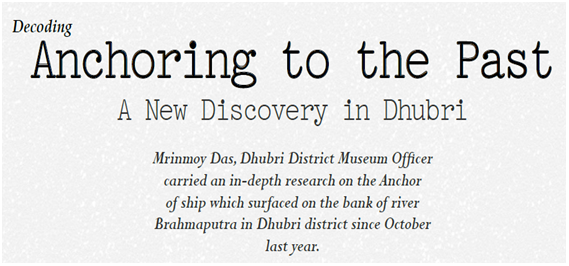
Following is the excerpt of an exclusive talk and conversation presented as it is: Mrinmoy Das on the background of research on the Anchor
Dhubri is situated on the western most part of Assam; this place with a rich history as the gateway to undivided Assam is where the mighty Brahmaputra ends before entering Bangladesh.
The geographical location and picturesque beauty of this part of Assam surrounded with forests, hills, rivers, lush green fields and plantations has attracted many past conquerors of different period to rule and settle here, including the Britishers. After the arrival of the British, Dhubri became an important administrative seat of the western powers. The present district has been carved out from the greater Goalpara district in the year 1983 after serving as the district headquarter for four consecutive years .
Mrinmoy Das on history of navigation in this part of Assam
The important elements of colonial architecture exhibited through the civic, administrative, institutional and utilitarian buildings in Dhubri reminds about the colonial legacy of the British Empire. It has been speculated that before the East India Company, it were the Armenian traders who arrived in Dhubri sailing through the Brahmaputra on their onward journey to Bangladesh from Calcutta.
administrative, institutional and utilitarian buildings in Dhubri reminds about the colonial legacy of the British Empire. It has been speculated that before the East India Company, it were the Armenian traders who arrived in Dhubri sailing through the Brahmaputra on their onward journey to Bangladesh from Calcutta.
Dhubri flourished as a major river port zone with traces of many navigational activities happening before and during the British rule. The river Brahmaputra serves as the lifeline of the place as most of the occupational and productive activities are related to the river. When the British entered Assam, Brahmaputra was the main artery of communication. After the first steam vessel “The Assam” plied in 1841, subsequently, a number of organized steamer vessels were introduced by the companies namely the River Navigation System (RNS) and Indian General Steam Navigation Company Limited (IGSNC).
The archaeological expeditions in Dhubri have also highlighted the presence of kingdoms and empires that once flourished under various rulers. The historical monuments, architectural remnants and buildings found in the region describe a rich repository of settlement of various rulers.
Mrinmoy Das on the discovery of Anchor
In the month of October, 2019 a new archaeological discovery was made on the riverbed of Brahmaputra in the Majerchar river block, 11 kms from Dhubri town, when a group of local boys while having a leisurely time swimming and sporting in the river accidentally bumped into a hard object. When pulled out from under two metre of sediment, this hard object that enticed the gathered locals at the site appeared to be an absolute unit of large sized iron Anchor of ship wreckage.
Twenty people came together to securely pull out this heavy weight from underneath the water bed. The iron chains attached to the anchor was found absorbed in the hump of sand dunes on its bank. The weight of the anchor made it impossible to retrieve the end part of the chain with bare hands, also, unavailability of necessary mechanical equipment and expertise was another factor to consider.
On my second visit to the site in the month of November, the anchor was found lying abandoned at the river bank with the chains still attached and buried on the sand dunes. Nevertheless, this discovery has opened up a new chapter in the history of navigational activity that took place in the region during the 16th century and onwards.
The experts revealing in this discovery are of the opinion that the iron anchor must be of a large ship that went down or must have been abandoned for reasons unknown. Since Dhubri was a major river port at the time of the British rule, spotting such vessels was not an unusual sight. In addition, it has been further speculated that it may be a part of the vessel used by the Armenians, whereas, to some, it might be from one of the many passenger steamers that the British used to ply.
Personal observation of the anchor indicated signs of wider possibility of finding more behind the buried iron chains on the north side. The direction of the anchor with the attached chains suggests for a possible finding of the ship wreckage some 40 metres away from the anchor, only if excavation is carried out.
However, from such observations nothing could be ascertained until deeper study and research is propounded. Since, Dhubri is prone to destructive floods every year and the Earthquake of 1951 left major impact on the course of river systems and the riverbeds, therefore an in-depth research, investigation and analysis into this finding could lead to a fresh clue in unfolding of many new discoveries.
Mrinmoy Das on his observation, opinion and mystery over the Anchor
Bijoy Kr Sharma
To read the further articles please get your copy of Eastern Panorama May issue @http://www.magzter.com/IN/Hill-Publications/Eastern-Panorama/News/ or mail to contact @easternpanorama.in


